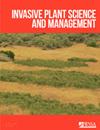怀俄明州一年生草地植被目测与线点截距调查方法的比较
IF 1.2
4区 生物学
Q3 PLANT SCIENCES
引用次数: 2
摘要
摘要科学家和自然资源管理者需要合适的植被调查方法来评估牧场恢复项目的成功与否。植被覆盖度的评价常用目测法和点截距法。本研究比较了单视觉(基于象限)和双线点截距(LPI,冠层和基底)方法在评估生物多样性和覆盖以及估计美国怀俄明州引入一年生草本植物入侵地点的生物量生产方面的性能。在象限中测得更大的物种丰富度和更高的Shannon指数值,而引入的一年生和本地多年生禾本科植物在LPI冠层中的覆盖值一般较高。总体而言,这些结果表明,当生物多样性监测是主要目标时,象限是最合适的调查方法,而当优先监测植被覆盖时,则建议LPI冠层。最后,我们的回归模型表明,基于象限的估计是预测引入的一年生和本地多年生禾本科生物量的最可靠估计。本文章由计算机程序翻译,如有差异,请以英文原文为准。
Comparison of visual estimation and line-point intercept vegetation survey methods on annual grass–invaded rangelands of Wyoming
Abstract Scientists and natural resource managers require suitable vegetation survey methods to assess the success of rangeland restoration projects. Visual estimation and point intercept methods are commonly used to evaluate vegetation cover. This study compared the performance of one visual (quadrat-based) and two line-point intercept (LPI, canopy and basal) methods to assess biodiversity and cover and to estimate biomass production on sites invaded by introduced annual grasses across Wyoming, USA. Greater species richness and higher Shannon index values were measured in quadrats, while introduced annual and native perennial graminoid cover values were higher in LPI canopy in general. Overall, these outcomes indicate quadrats as the most suitable survey method when biodiversity monitoring is the primary objective, while suggesting LPI canopy when monitoring vegetation cover is prioritized. Finally, our regression models indicated quadrat-based estimates as the most reliable to predict introduced annual and native perennial graminoid biomass.
求助全文
通过发布文献求助,成功后即可免费获取论文全文。
去求助
来源期刊

Invasive Plant Science and Management
PLANT SCIENCES-
CiteScore
2.20
自引率
9.10%
发文量
24
审稿时长
6-12 weeks
期刊介绍:
Invasive Plant Science and Management (IPSM) is an online peer-reviewed journal focusing on fundamental and applied research on invasive plant biology, ecology, management, and restoration of invaded non-crop areas, and on other aspects relevant to invasive species, including educational activities and policy issues. Topics include the biology and ecology of invasive plants in rangeland, prairie, pasture, wildland, forestry, riparian, wetland, aquatic, recreational, rights-of-ways, and other non-crop (parks, preserves, natural areas) settings; genetics of invasive plants; social, ecological, and economic impacts of invasive plants and their management; design, efficacy, and integration of control tools; land restoration and rehabilitation; effects of management on soil, air, water, and wildlife; education, extension, and outreach methods and resources; technology and product reports; mapping and remote sensing, inventory and monitoring; technology transfer tools; case study reports; and regulatory issues.
 求助内容:
求助内容: 应助结果提醒方式:
应助结果提醒方式:


